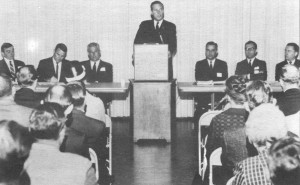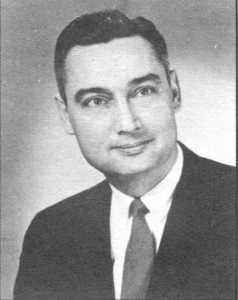Robert M. Utley: Founder of the National Historic Preservation Program
07 July 2015 – James Glass
preservation, government, The Public Historian, National Park Service, National Historic Preservation Act commemoration
Editor’s note: This post continues a series commemorating the anniversary of the National Historic Preservation Act by examining a past article published in The Public Historian, describing its significance and relating it to contemporary conversations in historic preservation.

Robert M. Utley (third from right) as a panelist at the Denver “New Preservation” conference, 1968. The National Park Service held eight regional conferences to explain the National Historic Preservation Act and its broad implications for preservation to the new State Liaison Officers for the act and interested members of the public. Photo credit: Washington Office, National Park Service
An able administrator and respected historian, Robert Utley was selected at age 34 by National Park Service Director George Hartzog to become Chief Historian. The new official spent most of his energies from 1964 to 1966 overseeing historians who made recommendations for the interpretation of historical units of the National Park System and others who compiled theme studies of potential National Historic Landmarks. But Utley also played a crucial role in developing the organizational structure needed to launch the new national historic preservation program.
In 2002, as part of The Public Historian’s Pioneers of Public History series, Park Service historian Ellen Foppes interviewed Utley (“Present at the Creation: Robert M. Utley Recalls the Beginnings of the National Historic Preservation Program”). I, too, had the privilege of interviewing Utley in 1986 as part of my research for a doctoral dissertation at Cornell University. From that interview and my review of documents at the National Park Service in Washington, I learned a great deal about Utley’s importance as a shaper of both the bill that became law and the actions taken by the Park Service to create a federal-state preservation program. I also obtained copies of two other recorded interviews with Utley–one by Herbert Evison in 1973 and a second by Richard W. Sellars and Melody Webb in 1985. In this post, I will review the 2000 interview and comment on Utley’s contributions to the framing of the National Historic Preservation Act and the national historic preservation program that resulted, based on my own interview and those in 1973 and 1985.
The Foppes interview emphasized the primary interests of Utley during his Park Service career: setting policy for research by professional historians into the significance of historic sites owned by the Park Service, devising appropriate interpretations of each site, and making recommendations for the proper preservation of the buildings involved.
As Chief Historian, Utley’s most lasting contributions involved the National Historic Preservation Act. Almost immediately, he wrote draft proposals for the Service to cooperate with the US Bureau of Outdoor Recreation and the federal Urban Renewal Administration in advising local communities how to conduct historic preservation projects. As momentum gathered for national preservation legislation in 1965 and 1966, Utley and the legal staff of the Park Service drafted the first version of the bill that eventually became law as the preservation act. They adopted almost entirely the system already in use for grants-in-aid to the states by the Bureau of Outdoor Recreation; the preservation bill would set up matching grants to the states for historic preservation. After the Johnson Administration’s bill was introduced in 1966, Utley wrote briefing papers for congressional hearings that explained how the federal-state program would work. Just as in the Outdoor Recreation program, State Liaison Officers (now State Historic Preservation Officers) in each state would administer the grants and prepare state historic preservation plans to guide the expenditure of federal funds.
Soon after the act became law in October 1966, George Hartzog established an Office of Archeology and Historic Preservation, to be modeled on some of the European monument services. In Utley’s words, Hartzog was an “empire-builder” who was interested in expanding the Park Service’s role into the historic preservation movement that was emerging during the 1960s in communities across the United States. Utley was appointed acting chief of the office and oversaw the creation of the new federal-state preservation program between late 1966 and mid-1967. Among his most important acts was to chair a committee of Park Service professionals who drafted the criteria for the new National Register of Historic Places. Utley supported basing the criteria on two existing Park Service criteria–those in use for National Historic Landmarks and those used for evaluating surplus federal properties for historical significance before transferring them to state or local governments.
After Ernest A. Connally was appointed the first Chief of the Office of Archeology and Historic Preservation, Utley as Chief Historian loyally supported his new boss. Although this office was initially intended both to implement the new act and to guide historic preservation projects in the parks, it soon became focused on external activities. Utley participated in a series of eight regional programs designed to educate the states about “the New Preservation” embodied in the preservation act, which stressed the importance of historic neighborhoods, downtowns, and works of architectural significance, as well as individual historic landmarks. In 1972, he became Director of the Office of Archeology and Historic Preservation and, for the next two years, worked with Connally to advocate within the Interior Department of the Nixon Administration for a new federal historic preservation agency detached from the Park Service and focused on the growing preservation movement outside the Park System.
In 1976, after returning for two years to a focus on historic preservation projects within national parks, Utley left the Park Service and finished his federal service as Deputy Executive Director of the Advisory Council on Historic Preservation. The Council oversaw federal agency compliance with Section 106 of the National Historic Preservation Act. Thus, Robert Utley alternated in his career between his core interests of history in the National Park System and guiding the new external national historic preservation program.
By every measure, Robert Utley should be judged one of the parents of the law itself and the federal-state program that resulted.
Looking ahead, the program Utley helped establish faces some challenges. After drastic cuts in the early 1980s, funding levels for participation by State Historic Preservation Officers (SHPOs) have only now returned to their 1980 amounts but are still substantially lower than in 1980 when inflation is factored in. Thus, the financial incentive for states to participate in the national program has shrunk over time, and with recent cuts in state funding, many SHPOs find it ever more difficult to carry out all of their responsibilities.
The coordinating bodies at the federal level–the Cultural Resources staff of the Park Service and the Advisory Council on Historic Preservation–are very small parts of the federal bureaucracy and, as such, often find it difficult to persuade each Administration and Congress to bring more resources to the program. Another challenge involves the federal historic rehabilitation tax credit program, administered by the Park Service and SHPOs, which has brought billions in private investment to historic properties in downtowns across the country. It faces potential elimination in the new Congress. Few in the preservation movement would question the importance of the federal-state program as vital infrastructure for historic preservation efforts. As the program enters its sixth decade, all sectors of the preservation field will need to dedicate themselves to strengthening the program if it is to prosper.
~ James A. Glass is Principal of Historic Preservation & Heritage Consulting LLC. He served twice as Deputy State Historic Preservation Officer for Indiana, and for 13 years he was Director of the Graduate Program in Historic Preservation at Ball State University. His 1990 book, The Beginnings of a New National Historic Preservation Program, 1957-1969, covers the role of Robert Utley in the founding of the national preservation program.




